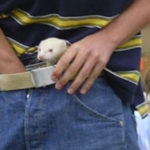 Weird Stuff
Weird Stuff  Weird Stuff
Weird Stuff  Our World
Our World 10 Ways Your Christmas Tree Is More Lit Than You Think
 Movies and TV
Movies and TV The 10 Coolest Stars to Set Sail on The Love Boat
 History
History 10 Things You Didn’t Know About the American National Anthem
 Technology
Technology Top 10 Everyday Tech Buzzwords That Hide a Darker Past
 Humans
Humans 10 Everyday Human Behaviors That Are Actually Survival Instincts
 Animals
Animals 10 Animals That Humiliated and Harmed Historical Leaders
 History
History 10 Most Influential Protests in Modern History
 Creepy
Creepy 10 More Representations of Death from Myth, Legend, and Folktale
 Technology
Technology 10 Scientific Breakthroughs of 2025 That’ll Change Everything
 Weird Stuff
Weird Stuff Ten Bizarre Facts About The Doge Meme
 Our World
Our World 10 Ways Your Christmas Tree Is More Lit Than You Think
 Movies and TV
Movies and TV The 10 Coolest Stars to Set Sail on The Love Boat
Who's Behind Listverse?

Jamie Frater
Head Editor
Jamie founded Listverse due to an insatiable desire to share fascinating, obscure, and bizarre facts. He has been a guest speaker on numerous national radio and television stations and is a five time published author.
More About Us History
History 10 Things You Didn’t Know About the American National Anthem
 Technology
Technology Top 10 Everyday Tech Buzzwords That Hide a Darker Past
 Humans
Humans 10 Everyday Human Behaviors That Are Actually Survival Instincts
 Animals
Animals 10 Animals That Humiliated and Harmed Historical Leaders
 History
History 10 Most Influential Protests in Modern History
 Creepy
Creepy 10 More Representations of Death from Myth, Legend, and Folktale
 Technology
Technology 10 Scientific Breakthroughs of 2025 That’ll Change Everything
10 Famous Pets Who Stole the Spotlight
In the animal kingdom, some furry and feathered friends have leaped, barked, and purred their way into the limelight, becoming more than just beloved pets. These standout stars have turned the heads of millions, not just with their adorable antics but with feats and stories that seem straight out of a movie.
From tail-wagging heroes to purring internet sensations, their escapades have captured our imaginations and hearts. They’ve shown us that animals can be much more than just cuddly companions; they can be trendsetters, record-breakers, and even history-makers. Each of these charismatic critters has a tale that’s as entertaining as it is heartwarming, proving that sometimes, the most memorable celebrities walk on four legs.
Related: Top 10 Exotic Pets You Can Buy (But Probably Shouldn’t)
10 Stubbs the Cat
In 1998, the small town of Talkeetna, Alaska, with a population of about 900, made a unique decision in its local governance by electing a cat named Stubbs as its honorary mayor. Stubbs, a yellow cat, was chosen through a write-in campaign and served as the town’s feline mayor for 20 years until his death. Stubbs passed away at the age of 20, leaving behind a legacy as a beloved figure in Talkeetna. His family fondly remembered him as a trooper who enjoyed snuggling and purring in their laps.
Stubbs’s tenure wasn’t without challenges; in 2013, he survived a severe attack by a neighborhood dog, which resulted in a punctured lung, fractured sternum, and deep lacerations. However, he recovered and resumed his mayoral duties. In his final years, he spent more time at home rather than his usual visits to the local Nagley’s General Store. He was highly popular, with over 75% of visitors to the store inquiring about him or claiming to have an appointment with the mayor.
As Stubbs aged, he began to retreat from public life around 2015, finding the attention and media exposure overwhelming. In the wake of his passing, his owners mentioned that another of their kittens, Denali, might take over his role, having followed closely in Stubbs’s pawprints.[1]
9 Pal (aka Lassie)
Lassie, the iconic movie star dog, began life as an unwanted, spirited puppy named Pal. In 1940, Rudd Weatherwax and his brother Frank, who had just started their own Studio Dog Training School, were approached by a man struggling with Pal’s behavior. Despite being from an AKC litter, Pal was deemed only “pet quality” and exhibited typical puppy problems like chewing and barking excessively.
Weatherwax agreed to train Pal for $10, but after a week, the owner, pleased with the newfound peace at home, offered Pal to Weatherwax instead of payment. Pal, now with the Weatherwaxes, didn’t have immediate prospects in film due to the lack of roles for collies. However, Weatherwax trained him for family life, including a skill to fetch his son, Bob, which would later prove helpful in films.
Pal’s break came when Weatherwax noticed a casting call for a collie in an upcoming MGM film. Despite initially being overlooked at the audition, Pal eventually got a chance for a screen test and impressed the director with his looks and training. Pal’s first film scene involved swimming across a river, which he executed perfectly, leading the director to proclaim, “The dog went into the water as Pal, but he emerged as Lassie!”
This marked the beginning of Pal’s career as Lassie. The success of Lassie Come Home in 1943 led to six more films starring Lassie. Throughout his career, the SPCA was always on set to ensure Lassie’s well-being. Lassie also became a radio star, featuring in The Lassie Show, the first radio program with an animal as the star.
Weatherwax and Lassie had to travel frequently between Hollywood and movie locations, eventually affording a private plane for convenience. As Lassie’s film career waned, Weatherwax secured the rights to the Lassie name and trademark, leading to road shows and eventually a television series. The original Lassie was succeeded by Lassie Junior for the television series but remained a beloved figure on set until his death in 1958 at age 18.[2]
8 Millie
Millie, an English springer spaniel, was the beloved dog of President George H.W. Bush and First Lady Barbara Bush. She gained fame as the first presidential pet to “write” a book, Millie’s Book: As Dictated to Barbara Bush, which became a New York Times nonfiction bestseller in 1992. In the book, Millie narrates her daily life at the White House, including attending briefings and meetings with the president, as well as her leisure activities like squirrel hunting.
Millie was not just a pet but also played a role in President Bush’s political life. During his re-election campaign, Bush humorously remarked that Millie knew more about foreign affairs than his opponents, Bill Clinton and Al Gore. Named after Mildred Caldwell Kerr, a close friend of the Bush family, Millie was also the mother of two other White House pets: Ranger, often referred to as Bush’s favorite dog, and Spot, who belonged to President George W. Bush.
Millie’s popularity extended beyond the political sphere. She appeared in several TV shows during the 1990s, including Murphy Brown, Wings, and Who’s the Boss, and even had a cameo in an episode of The Simpsons.
Sadly, Millie passed away from pneumonia in 1997 at the age of 12. Her memory is honored at the 15-acre Millie Bush Bark Park in Houston, which opened in 2004. Millie’s legacy continues to be celebrated at the Presidential Pet Museum, which was founded in 1999 to preserve the history and artifacts of presidential pets.[3]
7 Einstein the Parrot
Einstein, an African grey parrot at Zoo Knoxville in Tennessee, has gained internet fame for her extensive vocabulary and accurate impressions. During her 30th birthday celebration, a five-minute video of Einstein and her trainer, Adam Patterson, demonstrating her skills went viral. The parrot can produce around 200 sounds, including words, and can perform at least 70 on command.
Einstein’s popularity began in 2006 when she won the title of “Pet Star” on the Animal Planet game show. Later the same year, she appeared in a TED talk with trainer Stephanie White. There, she entertained the audience by imitating a variety of sounds, such as a spaceship, a monkey, and a skunk. This TED talk video has since accumulated over 2.2 million views. Additionally, Einstein has showcased her singing talent, once serenading Al Gore for his birthday.[4]
6 Doug the Pug
Doug the Pug, a six-year-old dog, has become an internet sensation, amassing over 12 million followers and a billion video views across social media. He has starred in a Fall Out Boy music video and is a New York Times best-selling author, accomplishments he shares with his owner, Leslie Mosier.
Mosier, a Tennessee resident, had always desired a pug named Doug since she was 13. She brought Doug home as a puppy in 2012. She utilized her social media management skills from her work with a record label and artist management company to transform Doug into a star. She created an Instagram account for Doug in October 2014, showcasing his charisma and her public relations skills.
Doug’s popularity skyrocketed when his photos gained traction on major Instagram accounts and attracted media attention from outlets like Mashable, TIME, and Good Morning America. The journey to fame was a collaborative effort. Mosier’s then-boyfriend, now husband, Rob Chianelli, assisted with video editing, filming, and photo shoots. Their breakthrough came with a viral video of Doug and a pug balloon, leading to numerous opportunities, including a book deal for Doug the Pug: King of Pop Culture.
In April 2015, Mosier quit her job to manage Doug’s career full-time. Doug’s fame has resulted in brand collaborations, music video appearances, and fan meet-and-greets. He has numerous celebrity fans and even conducted a photo shoot with Shakira in Barcelona. Despite a busy schedule, Doug’s well-being remains a priority for Mosier and Chianelli, who ensure his photo shoots are brief and enjoyable.[5]
5 Laika
Laika, a stray husky-spitz mix, became a significant figure in space history as the first living creature to orbit Earth. Her journey began in 1957 when Soviet engineers, responding to Premier Nikita Khrushchev’s request for a space mission to coincide with the 40th anniversary of Russia’s Bolshevik Revolution, hastily prepared Sputnik 2.
Unlike the unmanned Sputnik 1, this spacecraft included a pressurized compartment for Laika, who was chosen from a group of female stray dogs for her calm demeanor. The Soviet team expected Laika to survive in space for about seven days, anticipating her death from oxygen deprivation. However, complications arose soon after the launch. The loss of a heat shield caused the capsule’s temperature to rise significantly, leading to Laika’s death shortly after reaching orbit. Initially, Soviet authorities claimed she survived for several days, but it was later revealed that she died much earlier.
Laika’s mission was controversial, sparking debates about animal rights and the ethics of using animals in space exploration. Despite the tragic nature of her journey, Laika’s story has been immortalized in popular culture, including films, music, and literature. Her legacy is seen as both a symbol of sacrifice and a stepping stone in the advancement of space exploration. However, many rightfully view it as cruel. The Soviet Union and its allies commemorated her with stamps and memorials, and her story continues to resonate with people around the world.[6]
4 Boo
Boo, the Pomeranian famous as the “world’s cutest dog,” was a social media phenomenon with over 15 million Facebook followers and more than 500,000 on Instagram. His popularity extended beyond social media into a range of licensed products.
Boo starred in his own dedicated shop, offering print-on-demand products such as t-shirts, leggings, skateboards, and more, all featuring images of the adorable Pomeranian. Boo’s influence reached far and wide, from a book series and plush toys by Gund to appearances on Good Morning America, CNN, and QVC. He even became the official “spokespet” for Virgin Atlantic Airlines and Dr. Dre BEATS.
However, Boo’s journey ended in 2019 when he passed away in his sleep. His owners announced his passing on Facebook, where Boo had a 16-million-strong following. They believe Boo died of a broken heart following the death of his best friend, Buddy, in 2017. The news of Boo’s passing received over 245,000 reactions and 38,000 comments in just 14 hours, reflecting the deep connection his fans had with him.
Boo was more than just a cute pet; he provided comfort and joy to many. A fan shared how Boo helped them through their seven-year battle with cancer, underlining the emotional support pets often offer. Although heartbroken, Boo’s owners found solace in knowing he was no longer suffering, saying, “Boo, we love you with all our hearts and will miss you until the day we meet again. Have fun running around with Buddy and creating adorable mischief wherever you guys go.”.[7]
3 Grumpy Cat
Tardar Sauce, better known as “Grumpy Cat,” became an internet sensation after her photo was posted on Reddit. Her unique grumpy look, caused by feline dwarfism, made her an instant favorite due to the internet’s fondness for cats and humor about clinical depression, propelling her to stardom. However, Grumpy Cat’s fame extended beyond internet memes; she evolved into a highly successful brand.
Her image was featured on nearly 900 items in an official shop, and she became the face of Friskies, a cat food brand. In 2014, she even starred in a Lifetime movie, Grumpy Cat’s Worst Christmas Ever, with Aubrey Plaza providing her voice. Her brand was so influential that it led to a partnership with Garfield, another famous grumpy cat, in a book series.
Grumpy Cat’s financial success was substantial, though the exact figures were debated. In 2015, Grumpy Cat Limited, the company representing her, won a lawsuit against a coffee company for copyright infringement, securing $710,000. Despite passing away at the age of seven from a urinary tract infection, Grumpy Cat’s legacy lives on. She remains a beloved figure, immortalized in numerous memes for her endearingly unhappy face.[8]
2 Balto
Balto, a sled dog, played a pivotal role in the “Great Race of Mercy” in 1925. This race was a response to a diphtheria outbreak in Nome, Alaska. The only way to deliver the lifesaving serum from Anchorage, over 500 miles away, was via a dog sled relay across the perilous Iditarod Trail. The journey, usually taking a month, needed to be completed swiftly to prevent an epidemic.
Twenty mushers and their dog teams participated in the relay. Among them were Leonhard Seppala with his lead dog Togo and Gunnar Kaasen, who chose Balto, a three-year-old inexperienced Siberian Husky, to lead his team. The serum reached Nenana on January 27 and was passed from team to team, with each covering 24 to 52 miles (39 to 84 kilometers). Balto and Kaasen’s team, covering the final leg, faced severe challenges, including high winds that lifted the sled and dogs into the air. Despite these obstacles, Balto’s determination and focus remained unwavering, and they arrived in Nome just before dawn on February 2, completing the journey in an astonishing 127.5 hours.
Balto became a symbol of hope, teamwork, courage, and tenacity. Though Togo covered the longest and most dangerous leg of the relay, it was Balto who led the final, crucial sprint and became the face of the entire effort. Balto passed away in 1933 at age 14, but his legacy lives on.
A bronze statue in his honor stands in New York City’s Central Park, and he is featured in a special exhibit at the Cleveland Museum of Natural History. His story is celebrated annually in the Iditarod race, which follows the serum-run route, and was immortalized in an animated film produced by Amblin Entertainment in 1995. Balto’s name continues to inspire, with many puppies named after this heroic dog.[9]
1 Hachiko
Hachiko, often referred to as the world’s most loyal dog, was recognized for his unwavering devotion to his master. This cream-white Akita Inu was born in 1923 in Odate, Akita Prefecture, Japan. He became famous for his daily vigil at Shibuya Station in Tokyo, where he waited for his master, Hidesaburo Ueno, a distinguished agricultural professor, even years after Ueno died in 1925.
Hachiko’s tale was immortalized in various formats, including books, films, and even a Futurama episode. A bronze statue of Hachiko, first erected in 1934 and rebuilt after World War Two, stands outside Shibuya Station as a symbol of loyalty and devotion. Japanese schoolchildren learn the story of Chuken Hachiko (loyal dog Hachiko) as an exemplar of these qualities.
The Akita breed, to which Hachiko belonged, is among Japan’s oldest and most respected dog breeds, recognized for their calm, sincere, and brave demeanor. Hachiko’s story began when Ueno requested an Akita puppy; he received Hachiko, who was ill upon arrival but was nurtured back to health. Hachiko had accompanied Ueno to Shibuya station, a routine he continued even after Ueno’s unexpected passing, diligently waiting for him every day for almost a decade.
Hachiko’s loyalty endeared him to many, leading to nationwide recognition, food donations, and numerous visitors to the station to see him. His death in 1935 was widely mourned, with thousands visiting his statue in the subsequent days. Today, Hachiko’s legacy endures, with annual memorial services, his preserved remains displayed at the National Museum of Nature and Science in Tokyo, and several statues both in Japan and overseas.[10]








